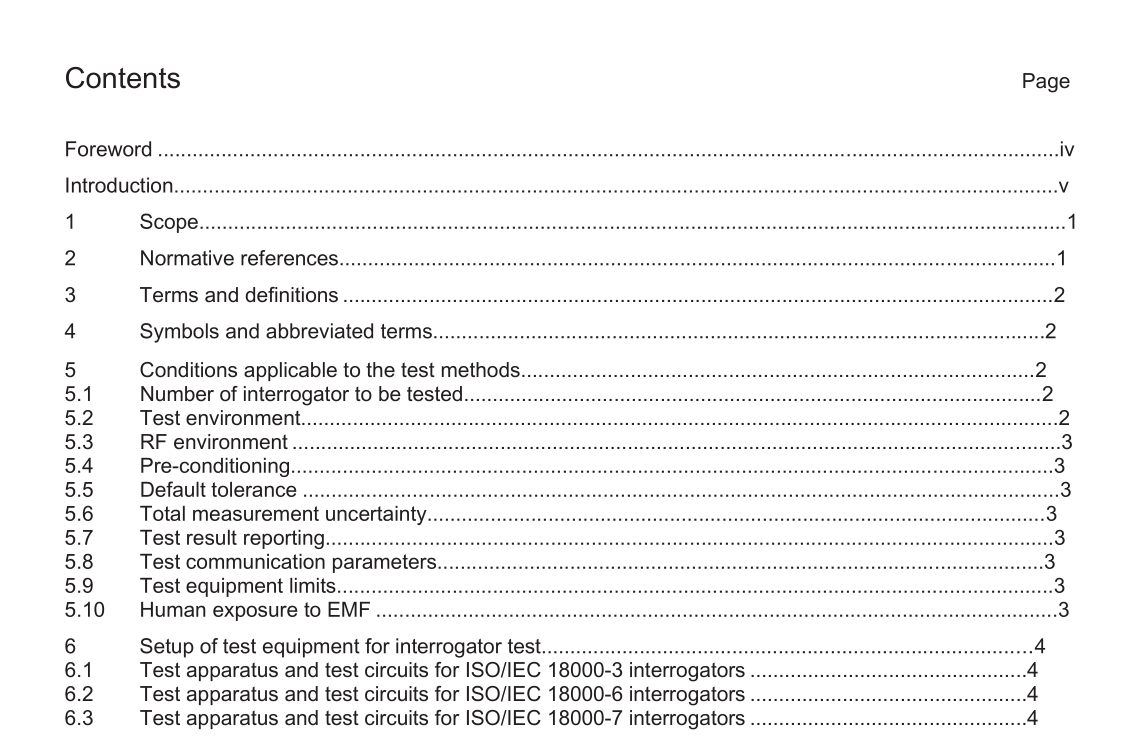BS ISO IEC 18046-2 pdf download.Information technology — Radio frequency identification device performance test methods — Part 2: Test methods for interrogator performance
1 Scope
This part of ISO/IEC 18046 defines test methods for performance characteristics of RFID interrogators for item management, and specifies the general requirements and test requirements for interrogators which are applicable to the selection of the devices for an application. The summary of the test reports form a unified tag datasheet. It does not apply to testing in relation to regulatory or similar requirements.
6 Setup of test equipment for interrogator test
6.1 Test apparatus and test circuits for ISO/IEC 18000-3 interrogators The specification for ISO/IEC 18000-3 tags and interrogators specifies an operating frequency of 13,56 MHz ± 7 kHz. Since both the interrogator and the tag may be shifted by 516ppm and potentially in opposite directions, the interrogator must function with a tag simulator that may be ±1032ppm (14 kHz) relative to the nominal centre frequency of the interrogator under test. This frequency adjustment will be made using only the tag simulator’s signal source since there may be no convenient way to adjust the frequency of the interrogator being evaluated. The relative Interrogator to Tag frequency shift is still achieved using this method. For convenience in setting up the signal source in the tag simulator, use a low carrier frequency at 13,546 MHz, a nominal centre frequency at 13,560 MHz, and a high carrier frequency at 13,574 MHz for all frequency offset tests. The set up of all test equipment shall be in an anechoic chamber or some other fully characterized and controlled location that is free from interference sources and propagation influences, such as significant signal reflections, absorptions, or blockages. Unless otherwise specified, all the tests should be run using a known reference antenna attached to the tag simulator. The tag simulator used for these test shall be able to receive interrogator commands and transmit tags replies compliant with ISO/IEC 18000-3. The command decoder must provide a signal to trigger a properly timed response from the code generator so that the entire assembly acts as a tag simulator.The output of the decoder in the tag simulator is also connected to a computer and appropriate monitoring software so that it can display the tag commands as received from the interrogator being tested in order to confirm that it is sending correct commands. The timing of the interrogator’s transmitted signal and modulation can be monitored using the output of the tag simulator’s receiver attached to a storage scope that has sufficient memory depth to allow the capture of complete interrogator/tag transactions. The interrogator is connected to a control and monitoring computer that allows issuing of wakeup and command transmissions. This software should also provide display of decoded data received by the interrogator to confirm that it is able to properly decode and output received tag responses. Unless otherwise specified, the recommended test distance between the interrogator’s location and the reference antenna attached to the tag simulator should be 75 % of the maximum working distance which can be obtained with the interrogator under test and the tag simulator. 6.2 Test apparatus and test circuits for ISO/IEC 18000-6 interrogators The test apparatus and test circuits for ISO/IEC 18000-6 interrogator tests will be the subject of future work and are not covered in this international standard. 6.3 Test apparatus and test circuits for ISO/IEC 18000-7 interrogators The specification for ISO/IEC 18000-7 tags and interrogators specifies an operating frequency of 433,920 MHz (±20ppm), which is approximately ±8,7 kHz. Since both the interrogator and the tag may be shifted by 20ppm and potentially in opposite directions, the interrogator must function with a tag simulator that may be ±40ppm (approximately 17,4 kHz) relative to the nominal centre frequency of the interrogator under test.
BS ISO IEC 18046-2 pdf download
